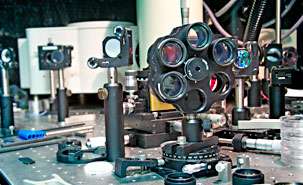The infinitely small tackles counterfeiting

The University of Montreal chemist Richard Martel explores a vast world on a tiny scale. "There are more H2O molecules in a sip of water [≈1024] than there are seconds since the Big Bang [≈1018]," he says to illustrate the scale at which he observes the Universe. In his laboratory, which is one of the most stable in Canada because of its seven-metre-deep foundations embedded directly in the Canadian Shield, he uses a low-energy electron microscope in which a vacuum has been created greater than the one surrounding the international space station. "This instrument," he says, "is like the astronomer's telescope. With it, you can look at matter at a minute scale, in the nanometre range, some 50,000 times smaller than a human hair.
The microscope/telescope comparison is not accidental; his business partner, Sébastien Blais-Ouellette, is an astrophysicist, whose doctoral thesis on the missing mass of the Universe won the France-Québec Prize for best thesis in 2000. Together, they have created a high-tech partnership that could transform the security industry. "By incorporating nanoparticles in an object, you can make it perfectly traceable," he explains.
Dye-coloured nanoparticles, or nanotags, can be added to objects in varnishes or inks. A scanner is then used to detect them and determine their vibrational spectrum, like fingerprints. "You can imagine a customs officer scanning your passport with this system; the spectrum obtained is like a highly accurate optical 'barcode,'" says Blais-Ouellete, President and founder of the company Photon Etc.
The Montreal company is betting heavily on this technology, and prototypes are being tested with partners in Quebec and Ontario.
The duo have also developed an optical imaging system, a Raman scattering imager, that uses a powerful laser beam to measure the vibrational spectrum of molecules from optical images. "This is a promising technology that could dominate in a few years. Photon etc. has already marketed the device," says the researcher.
Passports and banknotes
Due to their unique structure, carbon nanotubes can be used as containers for various molecules. Coupled with dye, these nanotags can increase the strength of the signal received. "We can thus detect the fingerprint of the encapsulated molecules through simple optical measurements, even at the scale of a single nanotube," says Martel.
These nanotags can be used in the ink of banknotes, making counterfeiting virtually impossible. The anti-counterfeiting market is estimated at $22 billion annually, notes Blais-Ouellette.
The carbon nanotube revolution could also affect the electronics industry, because unlike copper and other metals, these elements are transparent electrical conductors. A translucent screen made of thin layers of nanotubes would be almost invisible to the naked eye, and the transmission quality would be comparable to the best devices on the market today. The fundamental question of the conductivity of nanotubes in transparent films, which was treated by one of Martel's students, Carla Aguirre, has been cited over a hundred times since; the electronics world is constantly on the lookout for such innovations.
In medicine, carbon nanotags adhering to the surface of diseased cells could lead to improved diagnostics and even better treatment. "By reading the Raman signal from nanotags lodged on cancer cells in their early stages of development, we could identify the first signs of a tumour; thus, medical intervention would be more effective," continues the entrepreneur. Scanning the human body, the optical reader would make cancer cells visible.
While Martel welcomes applications based on his work on carbon nanotubes, it is not an aspect that consumes him. "I am first and foremost a scientist captivated by the architecture of matter. If others can use my discoveries to make products that sell, and the royalties allow to me pursue other work, so much the better!" he says.
Obviously, there is still a lot of work to be done, and the Montreal-based company Photon Etc. is exploring the same terrain as many high-tech companies. But the partnership with Université de Montréal is extremely promising. "Richard Martel is a visionary motivated by furthering knowledge. We are delighted to work with him because we see many applications of his work," says Blais-Ouelette.
For the physicist entrepreneur, it is a happy return to Université de Montréal, where his company was born 10 years ago in the business incubator that is the Joseph-Armand Bombardier Building, the same location where Richard Martel's team is exploring carbon nanostructures.
Provided by University of Montreal


















